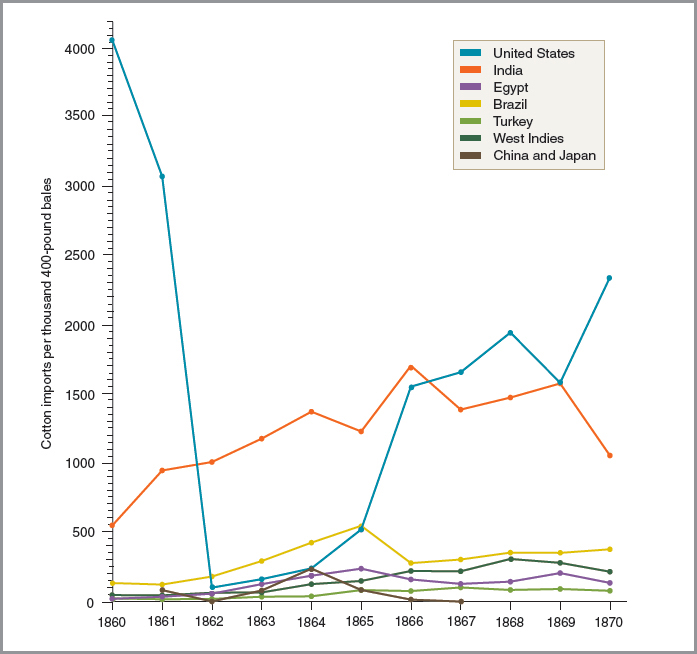International Diplomacy
Printed Page 436
Section Chronology
What the Confederates could not achieve on the seas, they sought to achieve through international diplomacy. They based their hope for European intervention on King Cotton. In theory, cotton-starved European nations would have no choice but to break the Union blockade and recognize the Confederacy. Southern hopes were not unreasonable, for at the height of the “cotton famine” in 1862, when 2 million British workers were unemployed, Britain tilted toward recognition. Along with several other European nations, Britain granted the Confederacy “belligerent” status, which enabled it to buy goods and build ships in European ports. But no country challenged the Union blockade or recognized the Confederate States of America as a nation, a bold act that probably would have drawn that country into war.
King Cotton diplomacy failed for several reasons. A bumper cotton crop in 1860 meant that the warehouses of British textile manufacturers bulged with surplus cotton throughout 1861. In 1862, when a cotton shortage did occur, European manufacturers found new sources in India, Egypt, and elsewhere. In addition, the development of a brisk trade between the Union and Britain — British war materiel for American grain and flour — helped offset the decline in textiles and encouraged Britain to remain neutral (Figure 15.2).
King Cotton diplomacy
 Confederate diplomatic strategy built on the hope that European nations starving for cotton would break the Union blockade and recognize the Confederacy. This strategy failed because Europeans held stores of surplus cotton and developed new sources outside the South.
Confederate diplomatic strategy built on the hope that European nations starving for cotton would break the Union blockade and recognize the Confederacy. This strategy failed because Europeans held stores of surplus cotton and developed new sources outside the South.
CHAPTER LOCATOR
Why did both the Union and the Confederacy consider control of the border states crucial?
Why did each side expect to win?
How did each side fare in the early years of the war?
How did the war for union become a fight for black freedom?
What problems did the Confederacy face at home?
How did the war affect the economy and politics of the North?
How did the Union finally win the war?
Conclusion: In what ways was the Civil War a “Second American Revolution”?
 LearningCurve
LearningCurve
Check what you know.


Europe’s temptation to intervene disappeared for good in 1862. Union military successes in the West made Britain and France think twice about linking their fates to the struggling Confederacy. Moreover, in September 1862, Lincoln announced a new policy that made an alliance with the Confederacy an alliance with slavery — a commitment the French and British, who had outlawed slavery in their empires and looked forward to its eradication worldwide, were not willing to make. After 1862, the South’s cause was linked irrevocably with slavery and reaction, and the Union’s cause was linked with freedom and democracy. The Union, not the Confederacy, had won the diplomatic stakes.
QUICK REVIEW